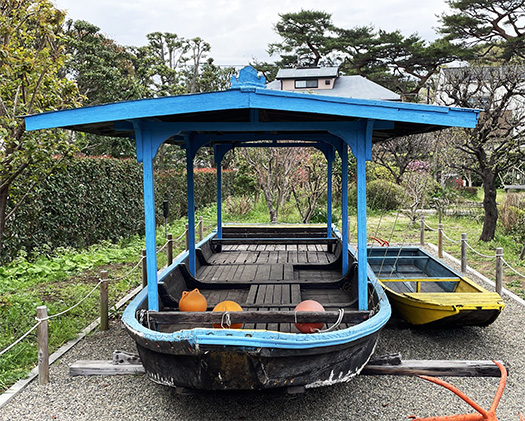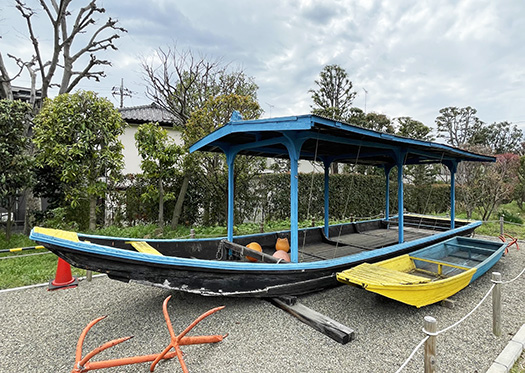


今週はあすから3泊4日で出掛けなければならないので、どうも慌ただしい。それまでに片付けたいこともあり、また来週はいろいろ立て込んでいる。じっくり連載ブログネタを考えるゆとりがない(泣)。
まぁ出掛けてしまえば、否応なく集中できるので逆にテーマもまとめられることと思います。で、本日は先日、多摩川縁の狛江で見かけた古民家の前に置かれていた「木造船」のことを書いてみたい。
木造建築の歴史を辿っていくと家を作る大工技術に先行して「船を作る」大工技術があったと言われる。人類史の中で定住はたかだか1.5万年前くらいからであり、それまでは「移動採集」が基本のライフスタイルだった。狩猟に適した地域に頻繁に移動するなかでは定置的な住まいより簡易な環境で済ませていた。洞穴住居とかが主流だったとされる。一方で人類は全大陸に進出した、特異で好奇心が異常に強いイキモノだったことから、相当早い段階から、水上移動の道具として船を造作してきたのだとされるのですね。
そしてその素材としてもっとも重宝されたのが木だった。葦船などの繊維素材もあったが、木を切って使うことが一般化した。そういう木造船の歴史があるのですが、近年そういう技術伝承は非常に疑わしい。この多摩川に面した狛江でそういう「船大工」の手業の痕跡を発見したのです。
かつて狛江と対岸の登戸の間には「渡し船」があったとされるのですが、昭和28年、高度成長期に多摩水道橋が掛けられて廃止されたのだという。
そういった時代変化の中で渡し船屋さんを経営していた「たまりや」の主人であり船頭でもあった谷田部氏は、水辺でのレジャー客を当て込んで、茶屋を始めた。それが当たって、周辺にも多くの茶屋・貸しボート屋が立ち並んだのだという。しかし昭和50年を過ぎるあたりから急減し、たまりやが最後まで生き残った。
そこで使われていた「屋形船」「漁船こ〜鮎などを捕獲するための小型船」が展示されている。これらは稲城市に住まわれていた船大工・久保井富蔵氏が設計施工した。同氏はグラスファイバー製に船の素材が移行する昭和50年代後半まで,多摩川中流域における最後の木造船・船大工として活躍された。
水深が浅い多摩川では、底が平らで浅い川船が使われたとされ、展示された船はそうした特徴をよく留めているとのこと。なにやら、地域の気候風土にジャストフィットを目指す住宅建築とよく似た製造スタイルだと思える。北海道では屋根は無落雪が主流になっていくけれど、そういうことと上下逆だけれどデザイン動機としてはよく似て、その地域・河川に柔軟に対応するものづくりの姿勢が見られると思います。
船大工と家大工、やはり通底するものがあるのでしょうね。
English version⬇
Traces of “ship carpentry” technology, older than that of house carpentry, along the Tama River.
Ferry boats are based on ship carpentry techniques. The unique characteristics of the river have fostered a culture of craftsmanship that is unique to the region. Traces of our ancestors’ creativity and ingenuity. The traces of our predecessors’ creativity and ingenuity.
This week is very hectic as I have to leave for 3 nights and 4 days starting tomorrow. I have a lot of things to finish before then, and I have a lot of things to do next week. I don’t have time to think carefully about my blog posts (I cry).
(Crying) Well, once I go out, I will be able to concentrate on my work, so I am sure I will be able to put together a theme. Today, I would like to write about a “wooden boat” I saw in front of an old house in Komae along the edge of the Tama River the other day.
If we trace the history of wooden architecture, it is said that the carpentry technique of “building boats” preceded the carpentry technique of building houses. In the history of mankind, settlement of settlements began only about 15,000 years ago, and until then, “migratory gathering” was the basic lifestyle. As people frequently traveled to areas suitable for hunting, they had to make do with simpler living conditions than stationary dwellings. Cave dwellings are believed to have been the norm. On the other hand, since humans were peculiar and curious creatures that expanded to all continents, it is believed that from a very early stage, they built boats as tools for traveling on the water.
And wood was the most valued material for them. There were also fiber materials such as reed boats, but cutting and using wood became more common. Such wooden boats have a long history, but in recent years, the transmission of such techniques has been very doubtful. We found traces of the handiwork of such “ship carpenters” here in Komae, which faces the Tama River.
It is said that there used to be a ferry between Komae and Noborito on the other side of the river, but it was discontinued in 1953 when the Tama Suido Bridge was built during the period of rapid economic growth.
Mr. Yatabe, the owner and boatman of “Tamariya” who ran the ferryboat shop in those changing times, started a teahouse, hoping to attract leisure customers to the waterfront. This was successful, and many teahouses and boat rental shops lined up in the vicinity. However, the number of teahouses and boat rental shops declined rapidly after 1975, and Tamariya was the last to survive.
The “houseboats” and “fishing boats – small boats used to catch sweetfish and other fish – that were used there are on display. These boats were designed and built by Tomizo Kuboi, a shipbuilder who lived in Inagi City. He was the last wooden boat builder in the middle reaches of the Tama River until the late 1975’s, when the material of boats was shifted to fiberglass.
In the shallow Tama River, flat-bottomed, shallow riverboats were used, and the boats on display retain these characteristics well. It seems to me that this style of manufacturing is similar to that of residential construction, which aims for a perfect fit with the climate of the region. In Hokkaido, snowfall-free roofs are becoming the mainstream, and although the design motive is upside-down, it is very similar, and I think it shows a manufacturing attitude that responds flexibly to the region and river.
I think there is a similarity between boat carpentry and house carpentry.







コメントを投稿
「※誹謗中傷や、悪意のある書き込み、営利目的などのコメントを防ぐために、投稿された全てのコメントは一時的に保留されますのでご了承ください。」
You must be logged in to post a comment.